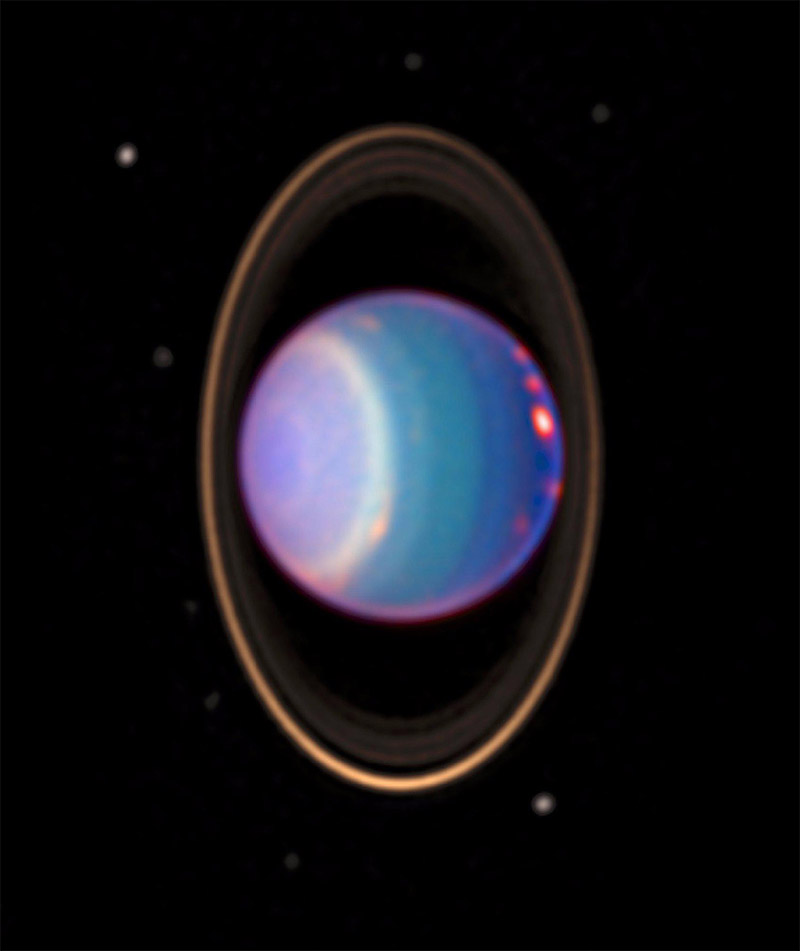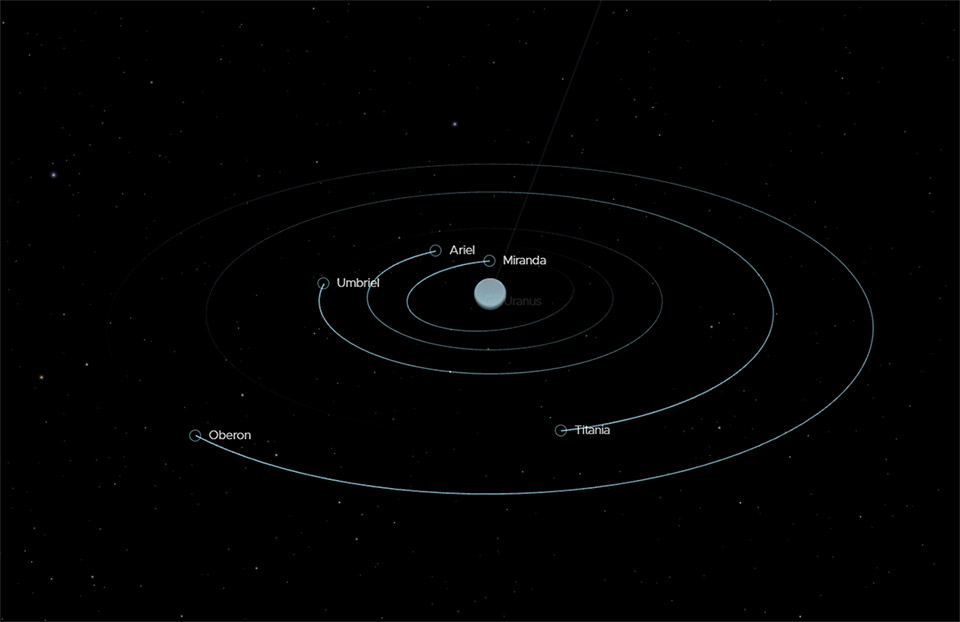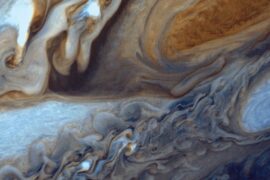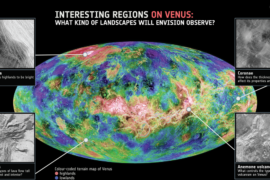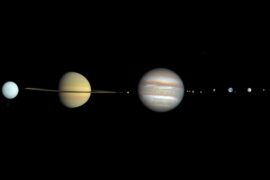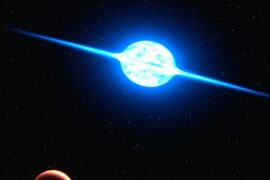Uranus is the seventh planet in the Solar system. It is surrounded by mystery because along with Mercury, it is one of the planets we know less about. We have never even sent a probe to study it. The only up-close photos we have of it were taken by the Voyager 2 spacecraft as it passed it by on January 1986 on its way out of the Solar system.
But what we know of Uranus is very interesting. Even though it has some similarities to its neighbors (Saturn and Neptune), it has some characteristics that make it unique.
In this article, we’ll take a look at some of these features that make this planet worth studying.
I know that is easy to make jokes about the name of this planet and it is almost impossible to talk about it without accidentally tripping into one but I’ll try to keep the puns to a minimum.
1. Uranus rotates sideways
Perhaps the most peculiar thing about Uranus when you compare it to the rest of the planets in the Solar system is that it is the only one that rotates (almost) sideways.
Uranus has a tilt of 97.7 degrees, which means that as it travels through its orbit, it does it looking more like a rolling bowling ball than a planet. This creates some unique effects on the planet, for example, it means that almost all the time, only one of its hemispheres and poles receives sunlight, creating a big difference in conditions between that side and the hidden one where the temperatures can drop all the way down to −224 °C (−371 °F).
On top of that, Uranus also rotates in the opposite direction than most of the other planets, which rotate counter-clockwise. In that regard, it is not alone, as Venus also rotates in the same direction.
This strange rotation is most likely the result of a collision between Uranus and another planet that might have been as big as Earth billions of years ago.
2. Uranus has rings just like Saturn
Saturn is very well-known for its rings, but it has a big secret. It is not the only planet with rings around it. Uranus also has them. It even has two sets of them. But they are much thinner and darker so they are rarely visible from Earth.
Uranus’ ring sits at a distance of 38,000 km from the atmosphere of the planet and extends for 60,000 km beyond that.
The rings were first reported by William Herschel, the original discoverer of Uranus, but they were so faint that everyone dismissed them as an imaging error. It was until 1977, more than two centuries later, and with much more powerful equipment, that a team of astronomers confirmed their existence.
Just like on Saturn, the rings are located more or less across the planet’s equator. And since Uranus spins sideways as mentioned above, if you were to look at a timelapse of the planet from up close, they’d look like a spinning wheel.
But wait! Uranus isn’t the only other planet to have rings. In fact, all the outer planets (also called Jovian planets) in the Solar system have them. You can find out more, including the reason why these planets have rings in our article about Jovian planets and their rings.
3. Uranus has LOTS of moons
The gravity on large planets is so strong that it captured lots of the material in their vicinity after their formation. This material got trapped around the orbits of these planets like Uranus and eventually formed multiple natural satellites, or moons as we commonly know them.
Uranus is pretty big. it has about 4 times the diameter of Earth and 14 times its mass.
As a result, Uranus has 27 moons that have been discovered so far. And I say so far because, with modern techniques and telescopes, we recently discovered Jupiter and Saturn had way more moons than we previously thought. Jupiter is up to 92 moons at the time of writing, so it is entirely possible that Uranus might also have some undiscovered satellites orbiting it.
Out of all these moons, five of them are considered the most important. These are Miranda, Ariel, Umbriel, Titania and Oberon. Titania is the largest with a diameter of 1578 kilometers which is slightly less than the size of Texas.
As I explained in our article about moon names, the moons of Uranus are named after literary characters, specifically from the works of William Shakespeare and Alexander Pope.
4. Uranus was discovered in modern times
The ancient civilizations knew of the planets and named them, but they only knew of them up to Saturn as that is the limit of visibility to the human eye.
When the telescope was invented in the sixteenth century lots of new stars and galaxies were discovered fast, but it was until 1781 that Uranus was discovered by William Herschel. It took another 65 years for Neptune to be found after that.
Since Uranus was the first planet to be discovered in (relatively) modern times, a controversy on how to name it started. Up to this point, the names of Roman gods had been used but that convention had been inherited since ancient times.
Hershel wanted (or felt obligated) to name it after his patron, king George III, and suggested the name Georgium Sidus (George’s star). The proposal wasn’t well met outside of England and it took almost 70 years for the international scientific community to finally agree on a name. The planet was named Uranus, which following the convention, was the Roman name of the Greek god of the sky, Ouranos.
5. You can’t simply walk into Uranus
Uranus and Neptune are sometimes referred to as “ice giants”, and they are also said to have a layer of ice below their atmospheres. This might lead to some confusion about the composition of the planet because it makes it sound like they have a solid ice surface and this just isn’t true.
Uranus is mostly made out of gas and it doesn’t have a solid surface. If we were to send out a probe to study the planet, it would just sink into the planet all the way down to its core. Well, actually, it would first be crushed due to the extreme atmospheric pressure, but let’s suppose we could build something that could withstand that.
When people say Uranus has an “icy layer”, in reality, it refers to a swirly mantle made out of dense fluids composed mostly of water and ammonia. Thinking of “ice” also leads us to believe this layer might be cold, but it is not at all. In fact, it is quite hot and it can reach pressures and temperatures so high that it is possible that could create something similar to rain, but instead of drops of water, it rains diamonds.
These conditions are what make the interior of gas planets so hard to study. Most of the information we have is based on models and many assumptions as we don’t have the technology yet to send a probe that could survive the trip to the interior for more than a few seconds. It also removes the possibility of humans ever going to these planets as we wouldn’t have a surface to walk on. Check out this article about what planets can humans walk on? for more.
6. Where does Uranus get its blue color from?
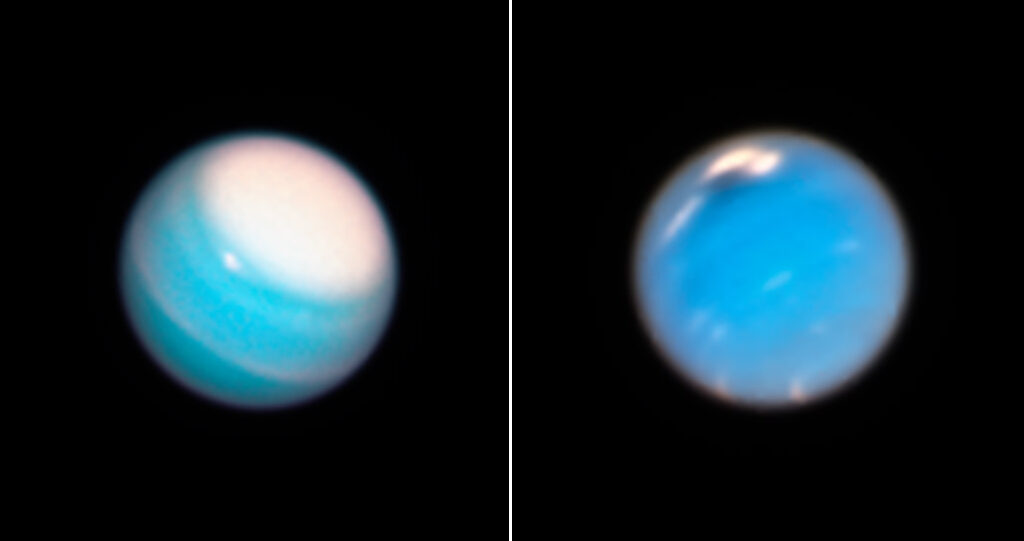
One more thing that leads to confusion about the ice composition of Uranus is its color. From the outside, the planet has pale blue tones with a bit of green in some areas. This adds up to the confusion about it being made out of ice.
But here’s the thing Uranus doesn’t even get its color from its “icy” layer.
The pale blue color of the planet Uranus comes from the high concentration of methane in its atmosphere that reflects the light. The planet’s atmosphere is so dense that it doesn’t allow sunlight to go through. What we see is just the cloudy exterior of the planet. All the colors that we see in Uranus are the result of the reflection of gases in the atmosphere.
Uranus’ atmosphere has the following composition:
| Element | Percentage |
|---|---|
| Hydrogen | 82.4% |
| Helium | 15.2% |
| Methane | 2.3% |
| Traces of others | < 0.1% |
7. Uranus has seasons
Seasons on a planet are the result of the rotation axis being tilted. As the planet orbits around the Sun, this makes certain areas receive more sunlight for larger periods of time while the opposite side of the planet receives less sunlight.
As mentioned earlier, Uranus is almost sideways> Its axis has a tilt of 97.7 degrees which makes one of its hemispheres and poles receive most of the sunlight for long periods of time.
This creates some extreme seasons on Uranus.
Just like Earth, Uranus has four seasons throughout its year. The problem is, one Uranian year takes slightly over 84 Earth years as that is the time it takes for the planet to complete one orbit around the Sun. This means that the Uranian seasons are also extremely long. The dark winter on the side of the planet that is not receiving sunlight lasts for 21 years at a time.
Enjoyed this article?
Get daily 10-minute PDFs about astronomy to read before bed!
Sign up for our upcoming micro-learning service where you will learn something new about space and beyond every day while winding down.


